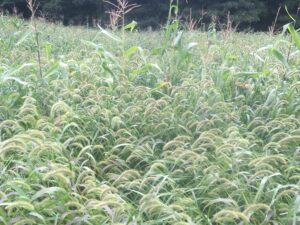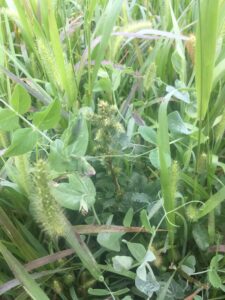Final report for FNE19-923
Project Information
We set out in search of a way to decrease pastured pork production costs while increasing soil health. We grew corn and field peas on the same plot of land for two consecutive years and allowed our pigs to harvest the corn and peas themselves. We measured growth rate of the pigs against a control group of pigs that were fed organic pig grain pellets. We submitted soil samples from the corn area before and after the project. We had varying success rates with growing the corn and peas between the two years, with too many variables to identify exactly why. However, with a healthy corn and pea crop, the savings in feed cost was very significant for the group harvesting the corn and peas ($0.36/pound of weight gain) versus the control group on commercial feed ($1.37/pound of weight gain). In addition, the soil test results showed a slight increase in organic matter as well as macro-nutrient levels, which is promising for the long-term sustainability of this practice. Our conclusion is that if we owned proper tillage and planting equipment (or better yet, a no-till planter), this could be a very viable option for both decreasing production costs, as well as improving soil health. We were able to give a tour to University of Rhode Island students, and we are currently finishing up a video with footage from the experiment as well as an interview summary of the project that will be uploaded onto the URI server as well as our farm website.
This project seeks to determine if hogging down corn and peas can substantially decrease pork production costs while maintaining or improving soil quality. Avoiding use of purchased feed will save us $2/pig/day, but we will have to weigh that against the difference in labor cost as compared to our control group of pigs on purchased feed. In addition we will need to measure pounds of liveweight gain in the two groups to determine if there is a difference in value increase of the pigs. Finally, we will measure the effect on the soil through soil tests before and after to look at soil physical parameters to determine if the practice of hogging down forages is improving soil health.
Our margins are so thin with our organic livestock production that we are constantly looking for ways to decrease costs. Our greatest input cost with hog production is purchased organic feed. In 2019, our farrow-finish operation cost just over $100,000 and $51,000 of that was feed. After researching alternative organic feed options, we decided to try growing our own feed, but to minimize further infrastructure costs, we have chosen to let the pigs harvest the feed themselves rather than harvest it by machine. In an attempt to improve our soils, we will be monitoring the change in soil physical parameters before an after two years of hogging down the corn and peas in order to determine if this is a potentially sustainable long-term option or if it is detrimental to soil health.
Cooperators
- - Technical Advisor
Research
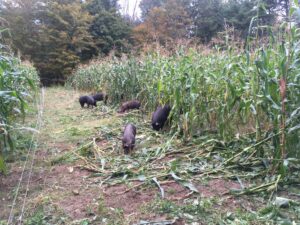
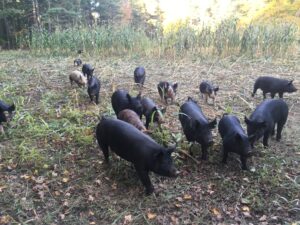
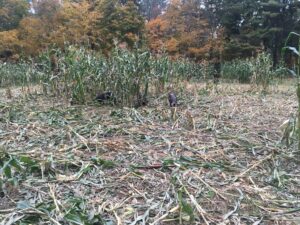
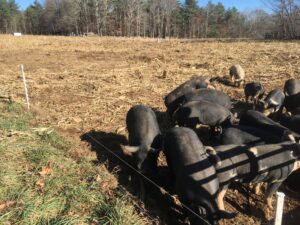
I ordered Wapsie Valley corn, 4010 forage pea, winter rye, and red clover seeds from Lakeview Organics on 3/14/19. An NRCS agent collected soil samples on 5/9/19. We set up pig fencing on 5/13/19 and moved (16) 200-lb pigs into first acre on 5/14/19. We moved the pigs to the second acre on 5/30/19. We moved them out on 6/19/19. During this time they had full access to organic hog grower feed from Green Mountain Feeds. They consumed 4200 lbs of feed. They grazed the pastures and kept them fairly short, but we were surprised at how little tillage they did. Since so much of the sod was still intact, we decided to plow it up, rather than just disc it, as we had written in our proposal. This proved much more time consuming than we had hoped, as there were many large stones just under the soil surface. We removed 8 tractor bucket loads of rocks from this 2 acre area, for fear of damaging the corn planter that we were going to borrow. After plowing and removing rocks, we disced the field twice.
We were late moving the pigs into this area because of wet ground and lack of time. The pigs took longer than expected to dig up the sod. The soil preparation took longer than expected. And we couldn't get the corn planter as soon as we had hoped because the farmer we were borrowing it from was using it. So even thought we had hoped to plant the first acre to corn and peas in mid-May and the second acre in early June, but we couldn't plant until late June, so we just planted both acres at the same time.
We borrowed a 2 row corn planter that was set for 30 inch rows and 7 inch spacing between plants. We did one pass with the corn, and then went back with the peas and planted them in between the corn rows, so essentially the rows alternated between corn and peas with 15 inch spacing between them. Since the planter had to be lifted out of the ground to turn, and since most of this area was close to perimeter fencing, we had to lift the planter with enough space to turn around. This left an unplanted 60 feet or so at each end. For curiosities sake, we tried broadcasting the corn and peas, at approximately the same density and then disc harrowed over it to see how well it would germinate in comparison. We were pleasantly surprised that it seemed to germinate and grow just about as well as the corn and peas planted by the planter. For this reason, and because of potential scheduling conflicts with the planter, we plan to try an earlier broadcast seeding next year instead of using the corn planter. If germination is poor, then we will still have time to disc it and replant with the corn planter.
This year the corn and peas grew very well. At the suggestion of our technical adviser, we took soil samples again when the corn was about a foot tall and submitted them for pre-sidedress Nitrate testing. The results came back showing 23 ppm, which we were advised was adequate for good corn growth. There were a few small locations of yellow corn plants with stunted growth, but most of it grew very well, reaching well over 10 feet by October.
A few days before moving the pigs into the corn, we began feeding whole corn plants to the pigs in order to adjust their digestive systems before removing their other feed. They loved it, and ate nearly the entire plants - stems, leaves, kernels, and cobs. We cut narrow swaths through the corn where we needed to install the temporary electric fencing. This is where the corn plants came from that we fed to the pigs before the experiment started.
We set up 2-strand polywire electric fencing and an automatic waterer in half an acre of the corn, and then sorted a group of 33 pigs into the corn (17 pigs) and control group (16 pigs). The control group was in a silvopasture environment, like the rest of our pigs, with full access to Green Mountain organic hog feed. The corn pigs learned within a few hours to knock the corn plants down in order to get to the cobs. They also ate quite a bit of the leaves and some of the stalks. At this point it was hard to tell how much of the peas they were eating.
One concern from the beginning was that they may not get enough minerals from the plants and soil, so we offered Fertrell's Grazier's Choice mineral just to see if they would like it. They loved it, and so we ended up feeding them some every day. During the experiment they consumed (2) 50-lb bags of minerals.
About every 8-10 days, the pigs had knocked over every corn plant and eaten nearly every kernel of corn, so we would move them to the next half acre. The day before moving the pigs, we would broadcast winter rye and red clover seed to allow them time to step it into the soil. We decided on this method rather than broadcasting and disc harrowing because it was so late into the fall and the soil was very wet from regular rain. We had some germination from the first two areas, but the second two areas were seeded so late, that we did not see any germination.
On the day that the corn pigs were done with the last half acre (11/13/19), we loaded them out and weighed them. We also weighed the control group.
|
Pig Group |
Beg. Avg. Wt. |
End Avg. Wt. |
Avg. Wt. Gain |
Cost/pig |
Cost/lb Wt. gain |
|
Corn |
176.47 lbs |
223.53 lbs |
47.06 lbs |
$286 |
$0.357 |
|
Control |
185 lbs |
247.5 lbs |
62.5 lbs |
$1367.40 |
$1.367 |
These costs do not include labor, which was nearly the same for the daily chores of each group. The main difference in labor was the time spent preparing the soil and planting the corn and peas, which was 19 hours.
2020 Update:
First day in corn - August 26, 2020
Giant Foxtail overtaking corn - August 24, 2020
Peas struggling to keep up with Foxtail - August 24, 2020
Just after pig move from 2nd to 3rd area - September 19, 2020
Tillage and Planting:
I ordered Wapsie Valley corn, 4010 forage pea, winter rye, and red clover seeds from Lakeview Organics on 2/12/20. We set up fencing and water for the first half acre to be tilled on May 6th. On May 11th we moved (17) 250-lb pigs into the first area for tillage. On May 18th we moved the pigs to the second half acre area. On May 22nd, we disced the first area twice to smooth out the ruts the pigs left and till in the remaining vegetation. We then broadcast seeded 12 lbs each of corn and peas with a shoulder-mounted Earthway seeder. Then we disced once more to bury the seed.
We decided on this method, differing from our 2019 approach, because the corn planter we borrowed was not available until the end of June, and we had to return it quickly. This led to a very late harvest date, and subsequent failure of our fall cover crop because it was planted too late, resulting in bare soil through the winter. We also were hoping for more staggered corn maturity so that the pigs could always be harvesting the corn at optimum nutrient levels. In 2019, we had planted the ends of the field (where we had to lift the corn planter in order to turn the tractor) with the "broadcast and disc-in" method. We had good results at an estimated 80% of the germination rate achieved with the corn planter.
Seeing that the pigs were not tilling as thoroughly as we had hoped, on May 22nd we added a group of (8) gestating sows to half of the fourth area for experimentation with a different class of pigs and to increase overall impact.
On June 8th we moved the pigs into the third area. We disced and planted the second area on June 12th using the same method as the first. On June 15th we moved the pigs into the remaining half of the fourth area. On June 22nd we disced and planted the third section again with the same method. On July 2nd we moved all of the pigs out of the corn area. Over this entire tillage period, the pigs consumed 7200 lbs of feed.
By this point we could observe the germination of the first two areas. In the first area about 50% of the area had germinated well, but the other 50% was just weeds. In the second area, very little corn or peas germinated at all, and weeds quickly took over. So we decided to alter our planting method for the fourth area, as an experiment. We disced the area twice on July 6th, and then dropped the seeds by hand into the furrows, at roughly 24" row spacing and 8" plant spacing. Thinking that the seeds may have been buried too deep by the disc harrow, we instead dragged a 12 foot long, 4x4 post behind the tractor that just knocked the ridges of soil into the furrows. This seemed to result in a more consistent planting depth around 2" deep. However, it was much more time consuming than simply broadcasting. And unfortunately, it did not result in any better germination than the "broadcast and disc-in" method.
By early August, the few corn plants that had germinated in the 4th section were about a foot tall, so we submitted a soil sample again for pre-sidedress Nitrate testing. We were curious if low nitrogen levels were contributing to poor growth and yellowing plants. The results came back at 52 ppm, which is more than double the previous years results, negating nitrogen levels as a contributing factor to crop failure.
By late August we had a beautiful patch of giant foxtail (with dotting of corn and pea plants) in the vegetative state, and we considered grazing it with our cattle, who had been transitioned to hay, as our pastures were all brown from drought. But we still wanted to see the results of the soil analysis at the end of two years grazing it with pigs, so we let it go and stayed on schedule to put the pigs in just as the few ears of corn matured. However, recognizing that there was not enough feed value in the corn to properly nourish the pigs, we decided to keep the pigs in the corn area on full feed. Instead of measuring the difference in cost between fully corn fed pigs versus fully grain fed pigs, we decided we would measure the difference in feed consumption between the control group of pigs raised in the woods and the "corn" pigs that got to graze (mostly on giant foxtail and other summer annuals).
It's worth noting that between planting and harvesting in 2019 we received 13.6" of total rainfall with 8 rainfall events of an inch or more, and in 2020 we received 6.2" of rainfall with no rainfall events of greater than 0.6". We had to feed hay to our cattle from July 20th to August 24th, because the pastures were all brown and dormant. This may have contributed significantly to the corn crop failure.
Harvesting:
On August 26th (96 days after planting), we weighed 36 pigs and divided them evenly into a control group and "corn" group. Each group had roughly even numbers from each of the four litters that made up the whole group. Each group had full access to Green Mountain's organic hog grower feed and water. Given the amount of crop residue left behind after the 2019 experiment, we knew discing would not adequately incorporate the plant residue or the cover crop seeds (winter rye and red clover). In other areas of our farm, we have enjoyed very good success with broadcasting cover crop seeds the day before we move pigs out of an area, in order to give them a chance to "plant" the seeds with their hooves. So we decided to use this method instead of discing in the seeds. Even so, there was so much standing crop and weed residue after the pigs left that we decided to brush-hog much of the area to give the cover crop a better advantage. All four areas needed some level of brush-hogging. We moved the pigs to the second area on September 8th; the third area on the 17th; and the fourth area on the 28th. The pigs were moved out, weighed, and recombined with the control group on October 12th.
The cover crop germinated well in all 4 areas and grew 2-4 inches tall before the end of the growing season. This was much more successful than the 2019 cover crop establishment.
During the experiment period, the corn pigs consumed 6340 lbs of feed and the control pigs consumed 5700 lbs of feed.
To complicate our calculations, the timing of the 2020 corn harvest was such that we had to take 6 pigs from the control group to harvest on September 28th. So we had to figure out average daily weight gains based on the number of pigs in each group on each day, multiplied by the number of days they were in the experiment, rather than weight gained over the entire course of the experiment. We also added the calculation of feed conversion (lbs of feed consumed divided by lbs of weight gained), since we altered the experiment by giving full feed to both groups, as a result of poor corn production.
2020 Calculations
|
Pig Group |
Beg. Avg. Wt. |
Avg. Daily Wt. Gain |
Feed conversion (Lbs Feed Consumed./lb Wt. Gain) |
Cost/lb Wt. Gain |
|
Corn |
227 lbs |
0.98 lbs/day |
7.63 lbs |
$2.75/lb |
|
Control |
218 lbs |
2.44 lbs/day |
3.02 lbs |
$0.87/lb |
Given that this doesn't compare apples to apples with our 2019 Calculation Table, we have gone back and made additional calculations for 2019 in order to make direct comparisons and to help us analyze the very unusual and unexpected results from 2020.
2019 and 2020 Calculations
|
Pig Group |
Beg. Avg. Wt. |
Avg. Daily Wt. Gain |
Feed conversion (Lbs Feed Consumed./lb Wt. Gain) |
Cost/lb Wt. Gain |
|
2019 Corn |
176.47 lbs |
1.34 lbs/day |
0 (no feed consumed) |
$0.357 |
|
2019 Control |
185 lbs |
1.79 lbs/day |
4.3 lbs |
$1.367 |
|
2020 Corn |
227 lbs |
0.98 lbs/day |
7.63 lbs |
$2.75/lb |
|
2020 Control |
218 lbs |
2.44 lbs/day |
3.02 lbs |
$0.87/lb |
These costs do not include labor. Daily chore time was similar for the two groups. The main difference in labor was the time spent moving the corn pigs (11 hours) and preparing the soil and planting the corn and peas (17 hours). I chose not to include these in the above tables as these numbers could vary significantly from one farm to another, based on pay rate, scale of farm, and available cultivation and planting equipment.
I was hoping to minimize variables in the soil analysis by having the same NRCS technician sample and submit our soil for testing. However, after several requests to several different people at NRCS in October, November, and December, we could not get them to come back out to test our soils. So I ultimately sampled and submitted the soil myself on December 29th to the same lab as the first test, as well as a second lab that we have used in the past and that returns results much more quickly.
The pigs only eating corn grew somewhat slower than the control pigs on commercial feed; however, the cost of production for the corn pigs was 26% of the cost of feeding commercial feed per pound of weight gained by the pigs. The control group of pigs consumed 4300 lbs of feed during the 35 day experiment. In 2019 we fed 82 tons of organic hog feed at around $630/ton which adds up to over $51,000. If we could grow all of the feed for our pigs and drop our feed bill to 26% of our current bill, this would be $38,000 annual savings. There would certainly be added difficulties and inefficiencies with year-round hogging down, when compared to our fall harvest, but nonetheless this shows significant potential for cost savings.
The major unexpected hurdles were the difficulty of soil preparation and the timing of borrowing someone else's corn planter. This combination led to a late planting date, and subsequently caused our cover crop seedings to have very poor germination. Next year we expect the soil preparation to be easier, as the pasture sod is already ripped up and many of the larger rocks have been removed from the field.
2020 results and discussion:
Our primary disappointment from the 2019 trial was the complete failure of the fall cover crop due to late planting. Several of our changes with the 2020 trial were aimed at improving cover crop establishment. Aiming to plant the cover crop at least a month earlier, we could not wait for the corn planter we borrowed in 2019, and we hoped to have a more staggered planting anyways, in order to harvest the corn at a consistent maturity. In 2019, by the time the pigs made it into the 4th area, the corn was well beyond mature. The leaves and stalks were totally brown. Given the drought of 2020, we can't be sure that the corn failure was entirely due to broadcast seeding instead of using the corn planter, but it seems a likely contributor. It is also possible that the corn was not as competitive being planted earlier because the soil was not warm enough for it to get ahead of the weeds.
The shocking results from the 2020 trial were the growth rate and feed conversion of the corn pigs. Average daily gain for the corn pigs was 40% the rate of gain of the control pigs, and 55% the rate of gain of the 2019 control pigs, yet they actually consumed more feed. These numbers are far enough off of what I would have expected to make me wonder if there was a data collection error or some significant unknown factor, like toxicity of a weed that inhibited growth, heat stress, or over-abundance of internal parasites.
As for the effect on the soil from 2 years of tillage, as well as 2 years of manure, we were fairly pleased with the results. I've included results midway through the experiment, from a second lab, and additional results from a third lab at the end of the experiment, in order to increase accuracy.
| Date | Lab | Organic Matter | Phosphorous | Potassium | Magnesium | pH |
| 7/17/19 | Cornell | 3.2 | Very high | High | High | 6.2 |
| 8/12/20 | UMass | 5.4 | High | Low | Very high | 6.2 |
| 12/29/20 | Waypoint | 3.8 | Very high | Low | High | 6.3 |
| 12/29/20 | Cornell | 3.4 | Very high | Very high | Very high | 6.4 |
Our main objectives were to decrease the cost of hog production by growing our own feed, while improving our soil quality. We will test the soil properties again after a second year of this experiment to determine the effect on soil health. We have seen a significant cost reduction in the first year of this experiment. The biggest variable for our farm and any other farms wishing to repeat this experiment is the amount of time it takes to prepare the soil and plant the corn. With previously cultivated land and the proper equipment, the cost savings of hogging down the corn and peas seems well worth it. We look forward to seeing the results of a second year of this experiment and the ultimate effects on soil health.
2020 conclusions:
After a disappointing corn crop, and confusing pig growth rates, we are left with a similar conclusion to 2019: if we had a larger tract of land and equipment for efficient soil preparation and planting, hogging down corn would seem well worth it. From a soil health perspective, we hesitate to draw any conclusions yet from the soil analyses, since they were done at different labs. However, given the widely accepted research showing that tillage depletes organic matter, and our preliminary test results, we are left very hopeful that hogging down crops may add more organic matter than is lost from the tillage used to plant the crops.
2021 conclusions:
After seeing both sets of final soil test results, it appears that there was very little change in soil health over the course of the experiment. Compaction increased slightly, while organic matter percentage and macro-nutrient levels also increased slightly. We are encouraged to see these slight increases in organic matter and nutrients, as tillage alone will generally cause a decrease in these levels.
Education & Outreach Activities and Participation Summary
Participation Summary:
We had planned an on-farm workshop with the Northeast Organic Farmers Association of Rhode Island for this fall, while the pigs were in the corn, but this was cancelled due to COVID. However, on October 19, 2020 we hosted a tour for the University of Rhode Island's Pasture and Grazing Management class, which included about 20 students (listed as farmers above), the professor, and extension agent (who is also the advisor for this grant). This was a general farm tour of our entire livestock operation, in addition to an explanation of this project and our preliminary findings.
We have also had several informal conversations with different farmers, who have found this project through internet searches. These have been very fruitful conversations, inspiring some other farms to initiate similar projects.
2021 Update:
Our technical advisor and URI extension agent, Andrew Radin and I, have put together an informational video which is posted on the URI extension server as well as on Youtube at https://www.youtube.com/watch?v=grbV_COcwiY. This video gives a summary of the project from why we wanted to pursue it, through our conclusions and summary.
Learning Outcomes
The big takeaways that farmers have mentioned gaining as a result of this project are:
- sows (or possibly other limit-fed pigs) are much more effective at tillage than full-fed finishing hogs
- broadcasting corn seed is likely not adequate enough for successful corn production, even in a system where mechanical harvesting will not be used
- a good corn crop is easily and efficiently harvested by pigs, and offers significant savings on feed costs
Project Outcomes
We are most excited about the possibility of improving soil organic matter through the practice of hogging down crops. We have applied for a grant (but not heard back yet) for this coming year to experiment with a much larger variety of cover crops to be planted and grazed in rotation by our pigs. We are weighing our focus more heavily on trying to improve organic matter, rather than trying to save on feed costs. So the crops we will be experimenting with tend to be easy to broadcast seed, quick establishing, biomass producing crops that we can graze and replant on a 60 day cycle. With the corn, we had to wait until June to plant and then 90 days until maturity to graze, so there was only one harvest per year. We are planning to start planting cool season crops in April, then warm season in June, and cool season again in August. We're aiming for 3 harvests per year, thereby producing and incorporating more biomass into the soil.
We are also considering purchasing a no-till seeder so that we can continue this type of experimentation but decrease the need for tillage even further.
The major "Ah-Ha" moment for us during this project, was in witnessing the recovery of the fields that have been hogged down versus the recovery of our silvopastures where our control groups were kept. I had the realization that when a pig knocks over a corn stalk or roots up our grasses and clovers, the recovery period was at most a year, and in some situations only a few months. But when a pig debarks an 80 year old tree, it will be 80 years recovery time to get back to what we had before the pig was there. So we have begun a major project of shifting all of our pigs into open pastures, and all of our cattle into the silvopastures.
Our project approach had the right core components, however, the data would be much more conclusive if carried on over a longer period of time. We felt limited by the 2 year time frame of the grant. It's very difficult to accurately ascertain a change in organic matter in only two years. We also had one group of pigs' growth and feed consumption data that seemed wildly far off of the rest, but with only 4 total groups, it is hard to know if that was due to human error, an anomaly, or a trend that would repeat itself under similar circumstances.
Relying on borrowed equipment was very unhelpful and led to in-the-field revisions that undermined consistency within the experiment. We are very interested in trying this again, but only if we own the planting equipment. We also are very excited to build on this project by experimenting with other cover crops.
The results of this project are most beneficial to small-scale northeast pig farmers. The outcomes could be very different in a region where farms are much larger, most of the land is arable, used equipment is easier to come by, and purchased feed is cheaper.

